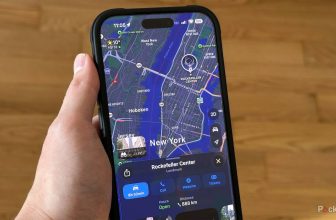Thin phones are in. The iPhone Air (not the iPhone 17 Air, as rumors previously suggested) will be the thinnest iPhone ever, or at least that’s what Apple claimed at its “Awe Dropping” product debut Tuesday. Whether that matters to you depends on the size of your pocket, though. If you were wondering just how this compares to the last-gen iPhone 16, we have most of the specs necessary to offer a point of comparison. The iPhone Air effectively replaces the usual Plus model in the latest smartphone lineup. If you were thinking about jumping on the upgrade, perhaps you should hold your horses and consider if you’ll be giving anything up for the sake of a cake-cutting iPhone.
The closest comparison to what you can get in the U.S. is the $1,100 Samsung Galaxy S25 Edge. That device’s 5.8mm thickness is slim enough to cut a slice of pie, but it also gives up flagship-level battery life with its 3,900mAh battery. The first iPhone Air will also miss out on the battery life Apple fans have come to expect from their phones. It’s better to think of the Air as an alternative device, a phone with a very specific use case (extremely thin pockets) and a user base with specific needs (wanting to be the cool kids on the block with the latest iPhone design).
But we’ll need to put the new Air through its paces. Perhaps, with time, it will prove as landmark a device as the original MacBook Air was close to two decades ago. Or maybe China-based companies like Tecno will figure out slim devices with good batteries far faster than the engineers in Cupertino. Time—as always—will tell.
iPhone Air Versus iPhone 16: Design
Your regular iPhone 16 came with several new features that would normally be relegated to the Pro models. For one, it featured an all-new Camera Control capacitive button used for snapping photos or modifying photo settings without having to touch the screen. It included Apple’s A18 chip, which sported a beefed-up CPU and GPU with enough power to handle on-device ray tracing; being close enough to the iPhone 16 Pro, the device felt like a bargain. The good news is the iPhone Air still has the Camera Control button as well as the Dynamic Island on the main display, rather than any sort of notch.
The iPhone Air boasts Ceramic Shield 2 on the glass and back for better scratch and crack resistance, plus titanium sides that are supposed to keep the device from bending under pressure. Apple’s older phone from 2024 was 7.8mm thin, which is standard for a phone that weighs in at just 170g, or .37 pounds. Few people would call that thick or heavy. Compared to the Air, the 16 is a brick. The iPhone Air weighs in at 165g, or .36 pounds. The difference in weight is so minimal, though at 5.6mm thick, the Air is many times thinner than the 16. If you want a point of comparison, glance at this video showing off the S25 Edge at 5.8mm versus the Air.
iPhone Air thinned comparison with Samsung Galaxy S25 Edge #AppleEvent pic.twitter.com/BlujtA6wV1
— Ray Wong (@raywongy) September 9, 2025
The major distinction between the old and new devices is what lies inside. Apple designed the Air from the ground up with new in-house 5G modems and wireless chips. The iPhone 16, by comparison, uses a Qualcomm-made 5G modem. The new device also comes stock with 256GB of storage for its base price, whereas the iPhone 16 makes do with 128GB. While the iPhone 16 and iPhone 17 sport a host of calming colors (pink, teal, and ultramarine blue), the base 17 also comes in calming lavender and sage hues. The iPhone Air will seem a little more mundane with black, white, light gold, plus a “sky blue” hue, which I imagine is similar to the gray-blue of the MacBook Air with M4.
iPhone Air Versus iPhone 16: Battery
If you’re looking for the main distinction between Apple’s new phone category and its battery. The iPhone 16 was rated for up to 22 hours of battery life in video playback tests, but in real life, we’ve seen the iPhone 16 go for more than a full day after regular use and still have some juice for the following morning. The iPhone 16’s battery capacity sits at 3,561mAh, which doesn’t seem especially high until you consider the limited refresh rate and Apple’s good standby power savings on the base iPhone.
Apple has yet to share precise specs for the iPhone Air’s battery capacity. Instead, the company repeatedly promised the device would have a “full-day” battery life. On the specs page, Apple said the Air managed to hit 27 hours in video playback tests, though only 22 hours when streaming. That’s better than a base iPhone 16, though not nearly as good as the iPhone 16 Plus, which the Air is effectively replacing in Apple’s 2025 iPhone lineup. Apple emphasized all the extra work it did to maximize battery efficiency.
iPhone Air with battery pack pic.twitter.com/dSy3jy8LAx
— Carolina Milanesi (@caro_milanesi) September 9, 2025
The iPhone Air promises to support a separate “iPhone Air MagSafe Battery” sold separately from the main unit. This battery, which is three-quarters the size of the actual phone, should push the battery life further at the cost of the thin frame. At least, the new device is compatible with the Qi2 standard up to 20W as well as MagSafe.
iPhone Air Versus iPhone 16: Camera
The older iPhone contained a 48-megapixel Fusion camera as well as a 12-megapixel ultrawide. The main sensor also enabled 12-megapixel 2x telephoto pictures. The device also made use of the TrueDepth camera for Face ID. The iPhone Air is notable since it contains a single camera bump, just like the iPhone 16e. The new device sports the 48-megapixel Fusion main camera that also allows for 2x, 12-megapixel telephoto shots. Unfortunately, there’s no ultra-wide lens to speak of. The new device can also handle 4K video up to 60 FPS, the same as the iPhone 16.
The Air has one sensor that beats the 16. The slim device sports an 18-megapixel “Center Stage” front camera compared to 12 megapixels on the iPhone 16. Apple suggested users would end up spending more time with the front camera with the inclusion of better image stabilization.
iPhone Air Versus iPhone 16: Display
With a 6.3-inch OLED display at 2,556×1,179 resolution, the regular iPhone was still a looker even compared to the larger, higher-resolution Plus model. The device was limited to a 60Hz refresh rate, which miffed some users when comparing their phones to mainline Android devices. Still, that means the device lasts longer compared to other devices.
The iPhone Air is slightly larger at 6.5 inches, less than the iPhone 16 Plus, though it sports a big, 2,736×1,260 resolution screen at 460 PPI, or pixels-per-inch—the same as the older phone models. However, the Air features a much faster screen at a 120Hz refresh rate that can go down to 1Hz if you enjoy an always-on display blazing from your nightstand.
First look at how thin the iPhone Air is #AppleEvent pic.twitter.com/0uMLAJayOi
— Ray Wong (@raywongy) September 9, 2025
The Air may have a brighter display at both HDR and SDR brightness for viewing outside, though the device is not designed to share screens over USB. Compared to the iPhone 16, which supported DisplayPort over USB-C, the iPhone Air doesn’t.
iPhone Air Versus iPhone 16: Chip
The iPhone 16’s A18 chip was one of Apple’s best for the regular iPhone, often meeting benchmarks of the A18 Pro-level chip except in intensive situations, like ray tracing scenarios when gaming. The A18 was built on a six-core CPU and five-core GPU design with a 16-core neural engine.
Not much has changed in configuration, though Apple swears the Air’s A19 Pro is a true next-gen chip despite it all. The A19 Pro uses a six-core CPU with two performance and four efficiency cores, alongside a five-core GPU (the iPhone 17 Pro devices make use of a six-core GPU, which will make them slightly better for graphics tasks). The device still supports hardware-accelerated ray tracing.
The A19 Pro is supposed to make the phone more energy efficient while improving on single-thread performance, which is how Apple is implying it should be able to handle simple tasks faster than before. How well it performs in the field, especially considering its awkward battery life specs, will determine if the thin frame is worth all the other small trade-offs.
Trending Products

Wireless Keyboard and Mouse Combo, ...

Lenovo New 15.6″ Laptop, Inte...

Dell Inspiron 15 3520 15.6″ F...

Acer Nitro KG241Y Sbiip 23.8” Ful...

Wireless Keyboard and Mouse Combo, ...

Zalman i3 NEO ATX Mid Tower Gaming ...

GAMDIAS ATX Mid Tower Gaming Comput...

Sceptre Curved 24-inch Gaming Monit...

Acer SH242Y Ebmihx 23.8″ FHD ...






